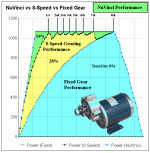safe
1 GW
- Joined
- Dec 22, 2006
- Messages
- 5,681
TylerDurden said:But we haven't heard how 50A doesn't generate heat...
I'm planning to use forced air cooling... but that's beside the point, most heat is not produced at the high end, it's at the low end. The "real world" average is what matters. I'll be able to adjust my boost level and will experiment with between 40 to 60 amps. My main interest is the gearing... I had to commit to an "estimated" boost level and 50 amps is what I'm gearing the bike for. 40 amps gets me to about 47 mph and would need a sprocket with a couple fewer teeth.
By now it's should be clear of what "steady state" riding is verses "sport" riding.
The perect solution is the Tesla style induction motor... but this is the closest you can get for sport bike performance using the permanent magnet motor.
"Steady State" riding doesn't interest me...





